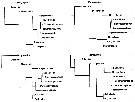|
|
 |
| Thaumatopsyllidae Sars, 1913 ( Cyclopoida ) | | Syn.: | Thespesiopsyllidae Wilson, 1924 (p.16); Wilson, 1932 a (p.393, 604); Sewell, 1949 (p.127); Fosshagen, 1970 a (p.38, Rem.); Isaac, 1975 (n°144/145, p.2, 7, clé spp.); Razouls, 1982 (p.753); Huys & Boxshall, 1991 (Rem., p.154, 193, 420, 467); Razouls, 1993 (p.311) | | Ref.: | Sars, 1913 a (p.4); 1921 a (p.4); Bowman & Abele,1982 (p.13: rétablissent ce nom de famille changé par Wilson (1924); McKinnon, 1994 (p.27, Rem.); J-s. Ho, 1994 (p.1295, Rem.); Ho, Dojiri, Hendler & Deets, 2003 (p.592, Rem.: creation of the new order: Thaumatopsylloida); Boxshall & Halsey, 2004 (p.16; 689: Def., p.691: Genera Key. These authors do not admit the new order Cf. p.41: Rem); Ferrari & von Vaupel Klein, 2019 (p.179: the family belongs to Ordre Thaumatopsylloida and the new Superorder; Rhabdomoplea. Rhabdomoplea appears to be the earliest branch of copepods because only rthoracic somites 1-4 are broad thoughout copepodid developement and thoracic somite 5 and 6 remain narrow, diggerent from Podoplea and Gymnoplea with thoracic somite 5 transformed from the anterior narrow somite to the posterior broad somite during the moult to copepodid II. Rhadomoplea differs from podoplea in their body architecture. | | Rem.: | 4 G: Australopsyllus, Caribeopsyllus, Orientopsyllus, Thaumatopsyllus
Morphological characters after Huys & Boxshall (1991, p.154) :
- Female genital apertures: paired and lateral.
- Caudal ramus: 7 setae.
- A1 female 15-segmented; male: 13 segments.
- A1: 2 segments distal to geniculation.
- Adult rostrum: present.
- Oral structures with labrum.
- P1 to P3: coxa and basis free.
- Inner coxal seta present..
P4 exopod2-segmented; endopod 1-segmented; intercoxal sclerite absent.
- P5 female: uniramous.
- P5 female exopod: free.
- P6: paired opercula.
Eggs into paired egg sacs. |  issued from : J.-s. Ho, M. Dojiri, G. Hendler & G.B. Deets in J. Crustacean Biol., 2003, 23 (3). [p.591, Fig.5]. The four, very similar, equally parsimonius phylograms, all showing the Thaumatopsyllidae as sister taxon to the Siphonostomatoida and Monstrilloida. Nota: The phylograms supports Sars' original hypothesis that Thaumatopsyllidae is allied with the Monstrilloida, and also indicate that Sewell (1949) and Fosshagen (1970) were correct to suggest its affinity to the Siphonostomatoida. The trees, however, refute Huys's and Boxshall's (1991) and Boxshall & Halsey (2004) transfer of the family to the Order Cyclopoida. An examination of the 54 characters reveals that thaumatopsyllids differ from Cyclopoida, and justifie the creation of a new order: Thaumatopsylloida. | | | | | (1) Australopsyllus McKinnon, 1994 | |
| | Ref.: | McKinnon, 1994 (p.27); Suarez-Morales & Castellanos, 1998 (p.203, Rem.) | | Rem.: | 1 sp. | | | | | (2) Caribeopsyllus Suarez-Morales, 1998 | |
| | Ref.: | in Suarez-Morales & Castellanos, 1998 (p.199); Boxshall & Halsey, 2004 (p.691) | | Rem.: | 2 spp. | | | | | (3) Orientopsyllus Sewell, 1949 | |
| | Ref.: | Sewell, 1949 (p.128); Razouls, 1982 (p.771); Huys & Boxshall, 1991 (p.193); McKinnon, 1994 (p.31, 32, Rem.); Suarez-Morales & Castellanos, 1998 (p.203, Rem.); Boxshall & Halsey, 2004 (p.691) | | Rem.: | type: Orientopsyllus investigatoris. Total: 1 sp. | | | | | (4) Thaumatopsyllus Sars, 1913 | |
| | Syn.: | Thespesiopsyllus Wilson, 1924 (p.16, Rem.); 1932 a (p.604); Sewell, 1949 (p.128); Fosshagen, 1970 a (p.33); Razouls,1982 (p.753); Huys & Boxshall, 1991(p.193, 467); Razouls, 1993 (p.312) | | Ref.: | Sars, 1913 a (p.4); 1921 a (p.4); Rose, 1933 a (p.338); McKinnon, 1994 (p.27, 32, Rem.); Suarez-Morales & Castellanos, 1998 (p.203, Rem.); Boxshall & Halsey, 2004 (p.691) | | Rem.: | type: Thaumatopsyllus paradoxus. Total: 1 sp. | | | | | |
|
|
 Any use of this site for a publication will be mentioned with the following reference : Any use of this site for a publication will be mentioned with the following reference :
Razouls C., Desreumaux N., Kouwenberg J. and de Bovée F., 2005-2026. - Biodiversity of Marine Planktonic Copepods (morphology, geographical distribution and biological data). Sorbonne University, CNRS. Available at http://copepodes.obs-banyuls.fr/en [Accessed January 18, 2026] © copyright 2005-2026 Sorbonne University, CNRS
|
|
 |
 |




